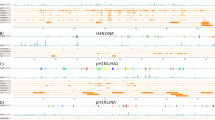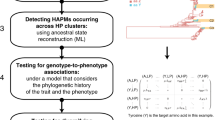Abstract
Studies examining positive selection on accessory proteins of HIV are rare, although these proteins play an important role in pathogenesis in vivo. Moreover, despite the biological relevance of analyses of molecular adaptation after viral transmission between species, the issue is still poorly studied. Here we present evidence that accessory proteins are subjected to positive selective forces exclusively in HIV. This scenario suggests that accessory protein genes are under adaptive evolution in HIV clades, while in SIVcpz such a phenomenon could not be detected. As a result, we show that comparative studies are critical to carry out functional investigation of positively selected protein sites, as they might help to achieve a better comprehension of the biology of HIV pathogenesis.
Similar content being viewed by others
References
Anisimova M, Bielawski JP, Yang ZH (2001) Accuracy and power of the likelihood ratio test in detecting adaptive molecular evolution. Mol Biol Evol 18:1585–1592
Anisimova M, Bielawski JP, Yang ZH (2002) Accuracy and power of Bayes prediction of amino acid sites under positive selection. Mol Biol Evol 19:950–958
Anisimova M, Nielsen R, Yang ZH (2003) Effect of recombination on the accuracy of the likelihood method for detecting positive selection at amino acid sites. Genetics 164:1229–1236
Choisy M, Woelk CH, Guegan JF, Robertson DL (2004) Comparative study of adaptive molecular evolution in different human immunodeficiency virus groups and subtypes. J Virol 78:1962–1970
Corbet S, Muller-Trutwin MC, Versmisse P, Delarue S, Ayouba A, Lewis J, Brunak S, Martin P, Brun-Vezinet F, Simon F, Barre-Sinoussi F, Mauclere P (2000) env Sequences of simian immunodeficiency viruses from chimpanzees in Cameroon are strongly related to those of human immunodeficiency virus group N from the same geographic area. J Virol 74:529–534
de Oliveira T, Salemi M, Gordon M, Vandamme AM, van Rensburg E, Engelbrecht S, Coovadia HM, Cassol S (2004) Mapping sites of positive selection and amino acid diversification in the HIV genome: an alternative approach to vaccine design? Genetics 167:1047–1058
Gao F, Yue L, White AT, Pappas PG, Barchue J, Hanson AP, Greene BM, Sharp PM, Shaw GM, Hahn BH (1992) Human infection by genetically diverse Sivsm-related HIV-2 in West Africa. Nature 358:495–499
Gao F, Bailes E, Robertson DL, Chen YL, Rodenburg CM, Michael SF, Cummins LB, Arthur LO, Peeters M, Shaw GM, Sharp PM, Hahn BH (1999) Origin of HIV-1 in the chimpanzee Pan troglodytes troglodytes. Nature 397:436–441
Heeney JL, Dalgleish AG, Weiss RA (2006) Origins of HIV and the evolution of resistance to AIDS. Science 313:462–466
Hirsch VM, Olmsted RA, Murpheycorb M, Purcell RH, Johnson PR (1989) An African primate lentivirus (Sivsm) closely related to HIV-2. Nature 339:389–392
Hughes AL, Westover K, Da Silva J, O’Connor DH, Watkins DI (2001) Simultaneous positive and purifying selection on overlapping reading frames of the tat and vpr genes of simian immunodeficiency virus. J Virol 75:7966–7972
Keele BF, Van Heuverswyn F, Li YY, Bailes E, Takehisa J, Santiago ML, Bibollet-Ruche F, Chen YL, Wain LV, Liegeois F, Loul S, Ngole EM, Bienvenue Y, Delaporte E, Brookfield JFY, Sharp PM, Shaw GM, Peeters M, Hahn BH (2006) Chimpanzee reservoirs of pandemic and nonpandemic HIV-1. Science 313:523–526
Khan MA, Aberham C, Kao S, Akari H, Gorelick R, Bour S, Strebel K (2001) Human immunodeficiency virus type I Vif protein is packaged into the nucleoprotein complex through an interaction with viral genomic RNA. J Virol 75:7252–7265
Korber B, Muldoon M, Theiler J, Gao F, Gupta R, Lapedes A, Hahn BH, Wolinsky S, Bhattacharya T (2000) Timing the ancestor of the HIV-1 pandemic strains. Science 288:1789–1796
Le Rouzic E, Benichou S (2005) The Vpr protein from HIV-1: distinct roles along the viral life cycle. Retrovirology 2:11. Available at: http://www.retrovirology.com/content/2/1/11
Marin M, Rose KM, Kozak SL, Kabat D (2003) HIV-1 Vif protein binds the editing enzyme APOBEC3G and induces its degradation. Nature Med 9:1398–1403
Pan C, Kim J, Chen LM, Wang Q, Lee C (2007) The HIV positive selection mutation database. Nucleic Acids Res 35:D371–D375
Pond SLK, Frost SDW (2005a) A genetic algorithm approach to detecting lineage-specific variation in selection pressure. Mol Biol Evol 22:478–485
Pond SLK, Frost SDW (2005b) A simple hierarchical approach to modeling distributions of substitution rates. Mol Biol Evol 22:223–234
Pond SK, Muse SV (2005) Site-to-site variation of synonymous substitution rates. Mol Biol Evol 22:2375–2385
Pond SLK, Frost SDW, Muse SV (2005) HyPhy: hypothesis testing using phylogenies. Bioinformatics 21:676–679
Pond SLK, Posada D, Gravenor MB, Woelk CH, Frost SDW (2006) GARD: a genetic algorithm for recombination detection. Bioinformatics 22:3096–3098
Posada D, Crandall KA (1998) MODELTEST: testing the model of DNA substitution. Bioinformatics 14:817–818
Scheffler K, Martin DP, Seoighe C (2006) Robust inference of positive selection from recombining coding sequences. Bioinformatics 22:2493–2499
Schubert U, FerrerMontiel AV, OblattMontal M, Henklein P, Strebel K, Montal M (1996) Identification of an ion channel activity of the Vpu transmembrane domain and its involvement in the regulation of virus release from HIV-1-infected cells. FEBS Lett 398:12–18
Seelamgari A, Maddukuri A, Berro R, de la Fuente C, Kehn K, Deng LW, Dadgar S, Bottazzi ME, Ghedin E, Pumfery A, Kashanchi F (2004) Role of viral regulatory and accessory proteins in HIV-1 replication. Frontiers Biosci 9:2388–2413
Sharp PM, Shaw GM, Hahn BH (2005) Simian immunodeficiency virus infection of chimpanzees. J Virol 79:3891–3902
Simon F, Mauclere P, Roques P, Loussert-Ajaka I, Muller-Trutwin MC, Saragosti S, Georges-Courbot MC, Barre-Sinoussi F, Brun-Vezinet F (1998) Identification of a new human immunodeficiency virus type 1 distinct from group M and group O. Nature Med 4:1032–1037
Stoddart CA, Geleziunas R, Ferrell S, Linquist-Stepps V, Moreno ME, Bare C, Xu WD, Yonemoto W, Bresnahan PA, McCune JM, Greene WC (2003) Human immunodeficiency virus type 1 Nef-mediated downregulation of CD4 correlates with Nef enhancement of viral pathogenesis. J Virol 77:2124–2133
Swanson WJ, Nielsen R, Yang QF (2003) Pervasive adaptive evolution in mammalian fertilization proteins. Mol Biol Evol 20:18–20
Swofford DL (2003) PAUP* 4b10. Phylogenetic analysis using parsymony (*and other methods). Sinauer Associates, Sunderland, MA
Thompson JD, Higgins DG, Gibson TJ (1994) Clustal-W—improving the sensitivity of progressive multiple sequence alignment through sequence weighting, position-specific gap penalties and weight matrix choice. Nucleic Acids Res 22:4673–4680
Tristem M, Marshall C, Karpas A, Hill F (1992) Evolution of the primate lentiviruses—evidence from Vpx and Vpr. EMBO J 11:3405–3412
Van Heuverswyn F, Li YY, Neel C, Bailes E, Keele BF, Liu WM, Loul S, Butel C, Liegeois F, Bienvenue Y, Ngolle EM, Sharp PM, Shaw GM, Delaporte E, Hahn BH, Peeters M (2006) Human immunodeficiency viruses—SIV infection in wild gorillas. Nature 444:164–164
Wain LV, Bailes E, Bibollet-Ruche F, Decker JM, Keele BF, Van Heuverswyn F, Li YY, Takehisa J, Ngole EM, Shaw GM, Peeters M, Hahn BH, Sharp PM (2007) Adaptation of HIV-1 to its human host. Mol Biol Evol 24:1853–1860
Wong WSW, Yang ZH, Goldman N, Nielsen R (2004) Accuracy and power of statistical methods for detecting adaptive evolution in protein coding sequences and for identifying positively selected sites. Genetics 168:1041–1051
Yang W, Bielawski JP, Yang ZH (2003) Widespread adaptive evolution in the human immunodeficiency virus type 1 genome. J Mol Evol 57:212–221
Yang ZH (2007) PAML 4: phylogenetic analysis by maximum likelihood. Mol Biol Evol 24:1586–1591
Yang ZH, Nielsen R, Goldman N, Pedersen AMK (2000) Codon-substitution models for heterogeneous selection pressure at amino acid sites. Genetics 155:431–449
Yang ZH, Wong WSW, Nielsen R (2005) Bayes empirical Bayes inference of amino acid sites under positive selection. Mol Biol Evol 22:1107–1118
Zanotto PMD, Kallas EG, de Souza RF, Holmes EC (1999) Genealogical evidence for positive selection in the nef gene of HIV-1. Genetics 153:1077–1089
Zhang H, Pomerantz RJ, Dornadula G, Sun Y (2000) Human immunodeficiency virus type 1 Vif protein is an integral component of an mRNP complex of viral RNA and could be involved in the viral RNA folding and packaging process. J Virol 74:8252–8261
Acknowledgments
This work is part of the requirements for the Master’s degree in Genetics of A.E.R.S., who is supported by a scholarship from the Brazilian National Research Council (CNPq). M.A.S. is supported by CNPq Grant 403589/2004-5 and Rio de Janeiro Science Foundation (FAPERJ) Grant E-26/170-545/2004. C.G.S. is supported by FAPERJ Grants 171.157/2006 and 110.627/2007 and grants from the FAPERJ programs Pensa Rio 2007 and Apoio às Instituições de Pesquisa 2007 to Claudia A. M. Russo. We would also like to thank the reviewers and the editor for the insightful comments that greatly enriched our article.
Author information
Authors and Affiliations
Corresponding author
Electronic supplementary material
Rights and permissions
About this article
Cite this article
Soares, A.E.R., Soares, M.A. & Schrago, C.G. Positive Selection on HIV Accessory Proteins and the Analysis of Molecular Adaptation After Interspecies Transmission. J Mol Evol 66, 598–604 (2008). https://doi.org/10.1007/s00239-008-9112-6
Received:
Revised:
Accepted:
Published:
Issue Date:
DOI: https://doi.org/10.1007/s00239-008-9112-6




